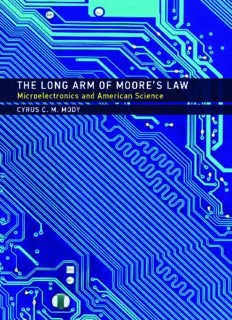
The Long Arm of Moore’s Law: Microelectronics and American Science PDF
Preview The Long Arm of Moore’s Law: Microelectronics and American Science
The Long Arm of Moore’s Law Inside Technology edited by Wiebe E. Bijker, W. Bernard Carlson, and Trevor Pinch A list of the series appears at the back of the book. The Long Arm of Moore’s Law Microelectronics and American Science Cyrus C. M. Mody The MIT Press Cambridge, Massachusetts London, England © 2017 Massachusetts Institute of Technology All rights reserved. No part of this book may be reproduced in any form by any electronic or mechanical means (including photocopying, recording, or information storage and retrieval) without permission in writing from the publisher. Set in Stone Serif and Stone Sans by Toppan Best-set Premedia Limited. Printed and bound in the United States of America. Library of Congress Cataloging-in-Publication Data Names: Mody, Cyrus C. M. (Cyrus Cawas Maneck), 1974- author. Title: The long arm of Moore’s law : microelectronics and American science / Cyrus C.M. Mody. Description: Cambridge, MA : The MIT Press, [2017] | Series: Inside technology | Includes bibliographical references and index. Identifiers: LCCN 2016020051 | ISBN 9780262035491 (hardcover : alk. paper) Subjects: LCSH: Microelectronics--Research--United States--History. | Moore’s law. | Science--United States--History. Classification: LCC TK7874 .M532525 2017 | DDC 621.381--dc 3 LC record available at https://lccn.loc.gov/2016020051 10 9 8 7 6 5 4 3 2 1 for Karen Cassandra Burk Contents Preface ix Introduction 1 1 Crisis and Opportunity at Vietnam-Era Stanford 25 2 IBM Gives Josephson Computing a Try 47 3 Molecular Electronics Gains a Reputation 79 4 New Institutions for Submicron Research 119 5 Circuits, Cells, and Networks 149 6 Synthesis at the Center 185 Epilogue 221 Notes 227 Index 279 Preface Preface and Acknowledgments Preface and Acknowledgments Many people contributed to this book, and those not listed here should know they have my thanks. A few individuals and organizations, however, merit mention for leaving their marks on specific sections of the manu- script. To begin with the title, the “Long Arm of Moore’s Law” tag line and a rudimentary version of the introduction were fashioned for a seminar at Amherst College to which Javier Lezaun and Susan Silbey suggested I be invited. Javier also got me into a workshop on interdisciplinarity at Oxford at which I presented parts of chapter 1, on which Sharon Traweek, Natasha Myers, and Steve Hilgartner gave much helpful feedback. The themes of that chapter first germinated in an essay review commissioned by Michael Gordin and Angela Creager and in a chapter for a handbook edited by Karin Bijsterveld and Trevor Pinch. The chapter also benefited from Christophe Lécuyer’s advice and collaborations with Andrew Nelson and Mara Mills. Chapter 2 began as a loose thread from my first book project, which I was able to follow thanks to help from Alan Kleinsasser. That chapter, and everything else I write, were further shaped by conversations with David Brock and Ann Johnson. Randal Hall and the members of the University of Houston Center for Public History discussion group also helped me refine the chapter. Chapters 3–6 would not have been possible without Hyungsub Choi and our decade of collaboration. Arthur Daemmrich inspired chapter 4 when he suggested I look at the Gordon Research Conference archives that the Chemical Heritage Foundation had recently acquired. Later, Hyungsub and CHF provided funding for a preliminary version of parts of chapter 6 through the Studies in Materials Innovation program. Chapters 3–6 were also improved by a summer at Bielefeld University’s Center for Interdisci- plinary Research, especially by conversations that summer with Alfred Nor- dmann, Hans Glimell, and Johannes Lenhard. Chapters 4 and 5 read better, I hope, thanks to refinements for conferences organized by Thomas Heinze
Description: